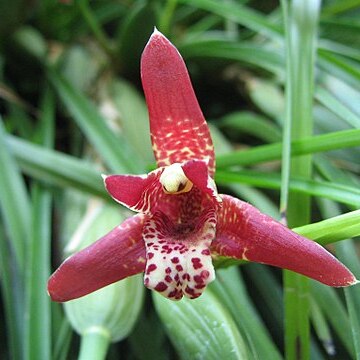Epiphytic herbs with very short to elongate, often branching, erect, arching or pendulous stems, with or without clustered or distant, 1-to 3-leaved pseudobulbs. Leaves persistent, condupli-ate in vernation, usually coriaceous or fleshy, rarely thin, usually strap-shaped, without prominent veins. Inflorescences of 1 to many, reduced to elongate, 1-flowered scapes from the bases of the pseudobulbs, from the axils of the leaves, or the flush of new growth. Flowers small to large and con-spicuous. Sepals subequal, free, or the laterals somewhat connate at the base, ad-nate to the foot or base of the column, often forming a short mentum. Petals subequal to the sepals or somewhat smaller. Lip concave, 3-lobed or entire, sessile or contracted at the base into a short claw, articulated with or adnate to the foot or base of the column, lateral lobes or margins erect, the mid-lobe membranaceous or thickened, spreading or reflexed; disk rarely without a fleshy callus. Column erect, semi-terete, somewhat arcuate, not winged, the base with a short foot, or footless. Anther terminal, operculate, incumbent, i-celled or imperfectly 2-celled; pollinia 4, waxy.
More
Herbs, epiphytic, rarely terrestrial, cespitose to climbing. Stems reduced [elongate], usually terminated with pseudobulb. Leaves 1–many; blade conduplicate, linear, lanceolate, or elliptic, margins entire. Inflorescences solitary flowers borne laterally within bract or leaf axil of rhizome of mature, immature, or apparently abortive shoots; floral bracts triangular, usually acute. Flowers: sepals and petals nearly same; dorsal sepal erect, concave; lateral sepals adnate to column foot; lip 3-lobed or simple; column not winged, semiterete, with foot at base; pollinia 4, waxy; stigmatic cavity round; rostellum not prominent. Fruits capsules, ellipsoid to obovoid.

